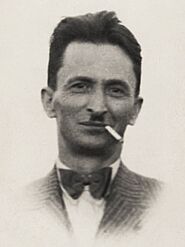Reşat Nuri Güntekin facts for kids
Quick facts for kids
Reşat Nuri Güntekin
|
|
|---|---|
 |
|
| Born | November 25, 1889 Istanbul, Ottoman Empire |
| Died | December 7, 1956 (aged 67) London, United Kingdom |
| Occupation | Novelist, story writer, playwright |
| Nationality | Turkish |
| Notable works | Çalıkuşu (1922), Yeşil Gece (1928), Yaprak Dökümü (1930) |
| Signature | |
Reşat Nuri Güntekin (born November 25, 1889 – died December 7, 1956) was a famous Turkish writer. He wrote many novels, short stories, and plays.
His most famous novel is Çalıkuşu, which means "The Wren" in English. This book, written in 1922, tells the story of a young Turkish female teacher in Anatolia. It has even been translated into Persian. Other important novels by him include Dudaktan Kalbe ("From the Lips to the Heart", 1925) and Yaprak Dökümü ("The Fall of Leaves", 1930). Many of his stories have been made into movies and TV shows.
Reşat Nuri knew the people of Anatolia very well. This was because he worked there as an inspector. His writings often showed the daily life and social challenges faced by people in Anatolia. He explored how people lived in their surroundings.
Contents
About Reşat Nuri Güntekin's Life
Reşat Nuri Güntekin's father was a doctor named Nuri Bey. Reşat Nuri went to primary school in Çanakkale. He also attended secondary school there and later the İzmir School of Freres.
He finished his studies at Istanbul University in 1912. He earned a degree from the Faculty of Literature.
His Career as a Teacher and Inspector
After university, Reşat Nuri worked as a teacher. He also became an administrator in high schools. He taught in cities like Bursa and Istanbul. His subjects included literature, French, and philosophy.
Later, in 1931, he became an inspector for the Ministry of National Education. This job allowed him to travel across Anatolia.
Reşat Nuri Güntekin in Politics and Diplomacy
From 1933 to 1943, Reşat Nuri served as a representative for Çanakkale. He was a member of the Turkish Parliament.
After his time in parliament, he returned to education. In 1947, he became the chief inspector at the Ministry of National Education. In 1950, he worked as a cultural attaché in Paris. This meant he helped promote Turkish culture abroad. He also represented Turkey at UNESCO.
Later Years and Passing
After he retired, Reşat Nuri Güntekin worked for the Istanbul Municipal Theatres. He was part of their literary board.
Reşat Nuri Güntekin passed away in London in 1956. He had gone there for medical treatment. He is buried in the Karacaahmet Cemetery in Istanbul.
Important Works by Reşat Nuri Güntekin
Reşat Nuri Güntekin wrote many different types of stories. Here are some of his most well-known works.
Popular Novels
- Çalıkuşu (1922) – Known as The Wren or "The Autobiography of a Turkish Girl."
- Dudaktan Kalbe (1923) – Means From the Lip to the Heart.
- Akşam Güneşi (1926) – Means Afternoon Sun.
- Yeşil Gece (1928) – Known as The Green Night.
- Acımak (1928) – Means To Pity.
- Yaprak Dökümü (1930) – Means The Fall of Leaves.
- Eski Hastalık (1938) – Means That Old Sickness.
- Değirmen (1944) – Means The Mill.
- Miskinler Tekkesi (1946)
- Ateş Gecesi (1953) – Means The Night of Fire.
Short Stories Collection
- Tanrı Misafiri (1927) – Means God's Guest.
- Sönmüş Yıldızlar (1928) – Means Extinguished Stars.
- Olağan İşler (1930) – Means Ordinary Matters.
Plays Written by Reşat Nuri
- Hançer (1920) – Means Dagger.
- Eski Rüya (1922) – Means The Old Dream.
- Ümidin Güneşi (1924) – Means Hope's Sun.
- İstiklâl (1933) – Means Independence.
- Hülleci (1933)
- Balıkesir Muhasebecisi (1971) – Means The Accountant Of Balıkesir.
Images for kids

